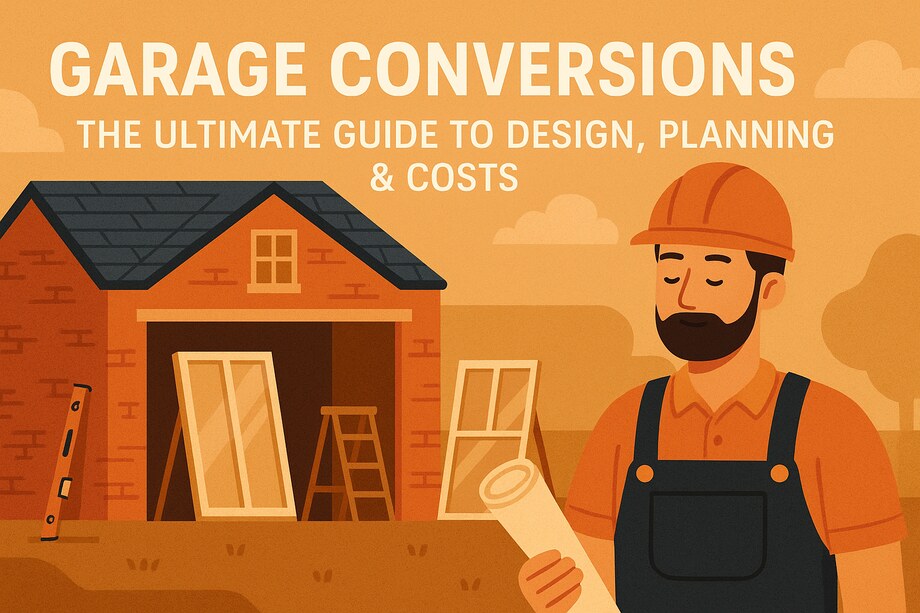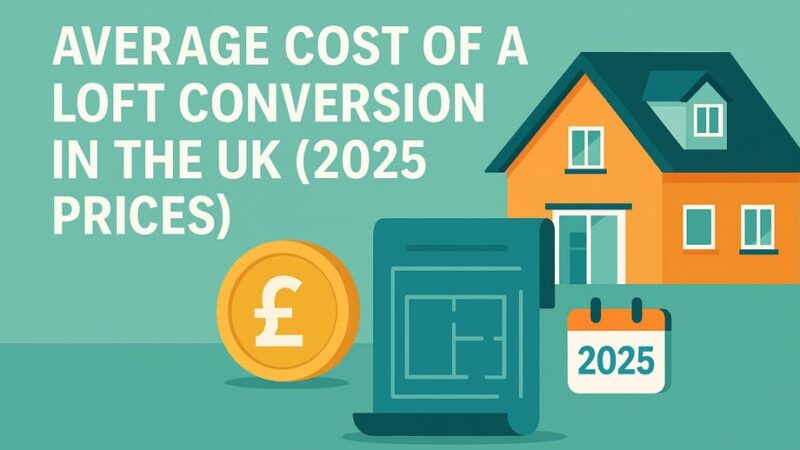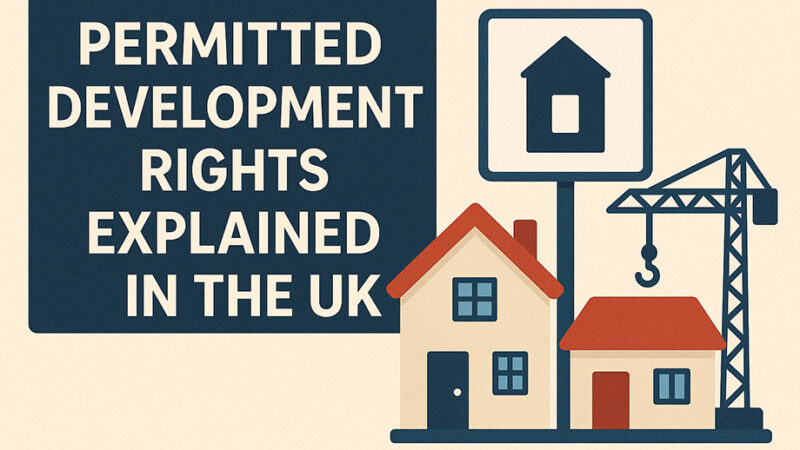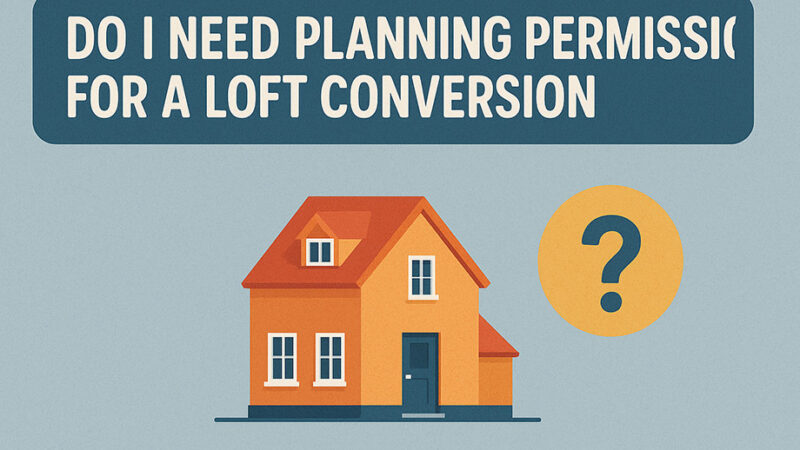Garage Conversions – The Ultimate Guide to Design, Planning & Costs

Garage conversions are one of the speediest and most affordable routes to adding flexible floor space to your existing home. The process will significantly enhance your home’s value and offer a versatile new space that can be used as a home office, bedroom, or even a small guest room complete with bathroom and kitchenette.
A garage conversion can fulfill a wide variety of functions, but ensuring you’re creating a successful design from the beginning will be key to the overall look, comfort and longevity of the newly converted space. This requires addressing insulation upgrades and fitting proper ventilation to make sure the new zone can be enjoyed all year round. You may also need to incorporate new electrical outlets, windows or accessibility features as part of the redesign.
Initial Assessment: Is Your Garage Conversion-Ready?
Before setting out on a project, you should assess the existing structure, particularly the soundness of the foundations, walls and roof. This will reveal the extent of works required to create a comfortable living space – a key part of the early design stages that’ll dictate what you’re able to do with the design later on.
Structural Evaluation Checklist
“A typical garage space has a floor-to-ceiling height of around 2.1m or more. Aim for 2m minimum of clear ceiling height and a good amount of natural light. With an average floor area of 20m² or more, most garages provide sufficient space for a new room without requiring an extension,” explains Bogdan Rusu from Vatraa Architecture.
Foundation Assessment: If you want to convert a garage to living space, investigate whether the existing foundations need upgrading to take the new loads post-conversion. This is particularly important if you’re adding new doors or windows. Foundation adequacy is usually assessed by digging trial pits – if foundations are at least 200mm deep, they should cope with domestic loads.
Floor Condition Analysis: An existing concrete garage floor might be strong enough for general domestic use. However, it may need levelling (consider self-levelling liquid screed), damp-proofing with a suitable membrane lapping into the walls’ DPC, and insulating to achieve adequate thermal performance. Garage floors tend to be lower than the main house, so it may be possible to incorporate all improvements while achieving a step-free threshold.
Structural Integrity Check: If the garage is in an especially dilapidated state, it may be cheaper to knock down and replace the structure with a newly-built, efficient version. This provides opportunity to specify features such as sustainable insulation or proper ventilation systems from the outset.
Planning and Regulatory Framework
Most garage conversions fall under permitted development rights, particularly when dealing with integral garages where most work affects interior spaces. The main external changes typically involve upgrading exterior cladding and adding windows – consider which materials complement your home best, such as slim-profile brick slips or timber cladding for a design statement.
When Planning Permission IS Required:
- Conservation areas where PD rights may have been removed
- Listed buildings requiring listed building consent
- Significant external appearance alterations
- Detached garage conversions to separate dwellings
- Properties with restrictive covenants requiring garage retention
You could apply for a lawful development certificate for peace of mind, or consider a pre-planning application to ensure your conversion project is on track for success.
Building Regulations: Always Apply
As garage conversions involve a change of use, they’re always subject to Building Regulations. For straightforward conversions, the building notice route may be sufficient – you simply inform the local authority 48 hours prior to commencing work without submitting structural drawings for scrutiny.
With more complex conversions, you may prefer full structural plans. This gives peace of mind that building control has inspected drawings and confirmed that construction per approved schematics will conform to regulations.
Building control officers will examine damp proofing, ventilation, insulation and energy efficiency, fire safety (including escape routes), electrics and plumbing. These are essential for a good-quality conversion that will be safe and comfortable.
Design Strategies and Space Planning
Maximising Garage Conversion Potential
Consider how you’ll use the space and how frequently, as this should help determine your garage conversion investment level. For higher-end conversion projects or larger double garage conversions, working with an architect could help identify creative ways to maximise potential and establish space that flows naturally into your home.
Space Planning by Garage Type:
Integrated Garage Conversions: If your garage is integrated or attached, the space should be fairly easy to work into your home’s main structure. You could knock through the wall to join with an existing zone – perhaps enlarging a hallway or creating a front-to-back kitchen-diner.
Detached Garage Solutions: A detached garage lends itself to segregated uses, such as an annexe or quiet home office. A single garage offers around 15m² of floor space – more than enough for a new living space, separate playroom, guest bedroom, or accessible downstairs shower and WC.
Double Garage Flexibility: At around 30m², a double garage conversion gives you more flexibility, especially for living space creation. It could house a bigger living room, ensuite bedroom, well-sized kitchen-diner or annexe. Alternatively, retain a single parking space by erecting a suitably insulated and fire-rated partition, then fitting out the rest for habitation.
Technical Construction Details
Wall Construction and Insulation
Integrated garages are often built to the same standard as the main house, so walls may already be insulated. If not, attached or detached garages of single-skin construction can be insulated internally by erecting studwork inside garage walls, using timbers deep enough to accept sufficient insulation plus an air gap, then plasterboarding over the top.
Insulated plasterboard may be an option for improving single-skin garage performance. Garages built with cavity walls can have insulation blown into the gap, preserving internal floor space.
For partial conversions retaining parking space, erect a fully-insulated internal dividing wall providing 30-minute fire protection. This can be blockwork or timber studwork lined with fire-line plasterboard on the garage side.
Roof Insulation Systems
The simplest way to insulate a garage roof is at loft level. With a pitched covering, 270mm of mineral wool should be sufficient – 100mm between joists, and the rest beneath them.
Warm roof setups, insulated at rafter level, are also possible and enable rooflights to bring in natural brightness. Garage conversions with flat roofs need rigid insulation between and under ceiling joists, with ventilation gaps above preventing condensation. To preserve floor-to-ceiling height, consider slim multifoil or PIR products.
Windows and Door Integration
The windows and doors you choose must suit your home’s style. For instance, timber stable doors might suit a detached oak-style structure. Building Regulations set minimum U-values of 1.4 W/m²K for new external doors and windows in existing dwellings.
Your conversion’s fenestration needs to match security expectations, provide adequate ventilation (probably requiring trickle vents for air quality), and suit your home’s style. To keep costs down, work to standard-sized units for new or replacement doors and windows.
For larger spans enabling open-plan feel, reinforcing steel beams may be needed – this requires structural engineer calculations. If creating a habitable room without direct protected route to external door, provide an escape window with minimum 450mm width and height, 0.33m² clear openable area, and bottom of openable area no more than 1,100mm from finished floor level.
Services Integration and Infrastructure
Electrical and Heating Systems
You’ll almost certainly need new electrical circuits and heating loops when converting a garage, putting additional loads on your consumer unit and boiler. If these systems need upgrading, this could easily add upwards of £2,000 to your project budget.
The most straightforward way to get infrastructure in place is engaging professionals qualified to self-certify their work under Part P of Building Regulations.
Lighting Design: Efficient LED downlights are excellent for garages, easily integrated into new ceiling structures. Plan lighting carefully and install conveniently placed sockets to accommodate this.
Heating Solutions: Plumbing in a suitably-sized radiator will be the cheapest heating solution. Slimline underfloor heating is a sleek alternative maximising floorplan and freeing wall space – either retrofit central heating UFH systems or electric UFH matting.
Water and Drainage: If planning a kitchen or bathroom in your garage conversion, account for hot and cold water supplies plus drainage. This typically requires extending existing house systems or creating new connections to mains services.
Ventilation Requirements: Ventilation is crucial for garage conversions. Openable windows fitted with trickle vents suffice in most cases – but incorporating bathrooms or kitchens requires powerful enough extractor fans managing moisture build-up.
Cost Planning and Budget Management
Realistic Cost Expectations
Provided the structure is in reasonable condition, converting a garage to habitable room should be more cost-effective than adding an extension or carrying out a loft conversion. A 15m² integrated garage in good condition could be converted for as little as £8,000 (£533 per m²), ready for your choice of internal fit-out.
Cost Variables by Garage Type:
- Integral garage: £533-£1,200 per m² (cheapest option)
- Attached garage: £750-£1,400 per m² (moderate complexity)
- Detached garage: £1,333-£2,000 per m² (highest cost due to services)
Detached garage conversions cost significantly more, partly because it’s trickier bringing in services – expect to pay from around £20,000 to renovate a standalone 15m² single garage. Even this should prove cheaper than most single-storey extensions, typically starting from around £1,900 per m².
Additional Cost Factors: Kitting your conversion with kitchen, bathroom or utility could add another £2,000-£3,000 in plumbing and electrical work – plus whatever you spend on furniture and fittings.
Professional Design and Build Routes
Working with Design Professionals
For higher-end conversion projects or larger double garage conversions, working with an architect could help identify creative ways to maximise your garage conversion potential and establish space flowing naturally into your home.
Another popular route is enlisting design and build companies specialising in garage conversions. Results can be fantastic and many will take your scheme through planning and building control as part of their fee. Their ground experience helps ensure smooth projects and predictable budgets you can see through to completion.
DIY Considerations
Taking on a DIY garage conversion can be a great option for those with slightly more limited budgets seeking simple schemes, allowing you to design and carry out work yourself. However, you’ll need certified installers for electrics and plumbing if your conversion requires heating.
Remember that windows tend to have the longest lead times – homeowners typically don’t factor this into garage conversion project duration estimates. Windows are ordered after structural openings are complete and ready for measuring. From that point, allow approximately 10-12 weeks for manufacturer’s drawings, production lead time and installation.
Timeline and Project Delivery
Realistic Project Scheduling
Overall, garage conversions can take 4-6 months to complete depending on complexity. Any bespoke joinery and furniture will extend this timeline.
Phase-by-Phase Breakdown:
- Design and approvals: 6-10 weeks
- Structural work: 3-6 weeks
- Services installation: 4-8 weeks
- Finishing trades: 4-6 weeks
- Final inspections: 1-2 weeks
Managing Construction Impact
Before garage conversion projects start in earnest, walls and roof must be made sound and watertight. Thereafter, most work takes place inside the existing garage. The first job involves stripping out the main structure, providing the clearest view of what’s in store – including where you’re most likely to encounter unexpected problems such as patchy foundations or hidden wall issues that could add to costs.
Specialist Considerations and Technical Requirements
Building Regulation Principal Designer Role
With latest Building Regulations changes, you need an architect to take the Building Regulations principal designer role from design start to construction end. This statutory requirement makes DIY projects more difficult without an architect, ensuring converted garages becoming part of your liveable space are safe and constructed to required standards.
Besides general safety, it’s important using the right insulation types for walls, ceilings and roof to prevent heat loss and avoid condensation. An architect can make such technical suggestions plus help with design aspects like better space use, better integration with house and garden, and pleasant overall feel.
Material Selection and Performance
Choose materials that complement your existing home while meeting performance requirements. For external elements, consider how new cladding or window materials will integrate with your property’s character.
The most common route is replacing the main garage door with conventional walling matching the rest of the building. In most cases this would be masonry infill, fully toothed and bonded into existing brickwork. Planning allowing, you could add windows or glazed doors introducing more daylight into your new space.
Some choose keeping the garage’s original doors to retain the structure’s character – just check these are in suitable condition.
Value Creation and Investment Returns
Maximising Conversion Value
Unless you specifically need garage space for storage or parking a car, it’s generally advisable to consider converting the garage and turning it into part of your home. You would first need assessing adequate height and floor space, considering that building control would require insulating your garage to make it part of liveable space. If unsure, contact an architect for initial assessment.
The ultimate garage conversion cost depends on the kind of space you’re creating and quality of finish you want to achieve. A well-planned garage conversion can significantly increase property value by as much as 20%, making it one of the most cost-effective home improvement projects available.
Design Integration Success Factors
Successful garage conversions create spaces that feel naturally part of the home rather than obvious additions. This requires careful attention to:
- Ceiling height consistency with adjacent rooms
- Flooring transitions that create seamless flow
- Lighting design that compensates for limited natural light
- Temperature control that integrates with existing systems
Converting your garage successfully requires balancing technical requirements with design vision, creating functional space that enhances both your lifestyle and property value. With careful planning, professional execution, and attention to building performance, your garage conversion can deliver exceptional returns on investment while providing years of enhanced living.
The key lies in treating your conversion as an integrated part of your home’s architecture rather than simply additional space. Consider how the new area will function within your property’s overall layout, how it will be used throughout different seasons, and how it contributes to your home’s long-term value and appeal.
Last Updated on August 5, 2025 by James Cartwright







